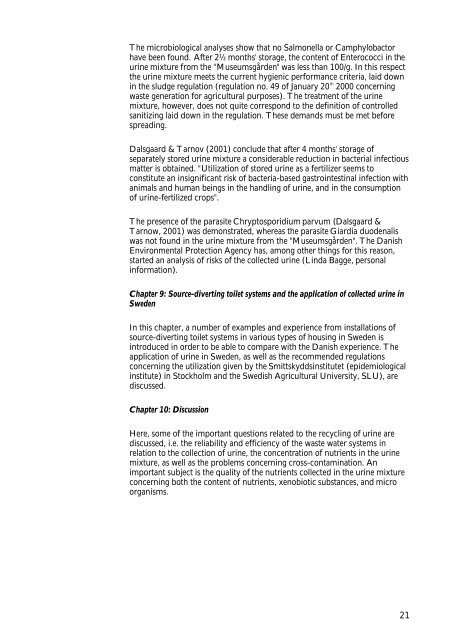Opsamling, opbevaring og udnyttelse af urin fra ... - Miljøstyrelsen
Opsamling, opbevaring og udnyttelse af urin fra ... - Miljøstyrelsen
Opsamling, opbevaring og udnyttelse af urin fra ... - Miljøstyrelsen
Create successful ePaper yourself
Turn your PDF publications into a flip-book with our unique Google optimized e-Paper software.
The microbiol<strong>og</strong>ical analyses show that no Salmonella or Camphylobactor<br />
have been found. After 2½ months' storage, the content of Enterococci in the<br />
<strong>urin</strong>e mixture from the "Museumsgården" was less than 100/g. In this respect<br />
the <strong>urin</strong>e mixture meets the current hygienic performance criteria, laid down<br />
in the sludge regulation (regulation no. 49 of January 20 th 2000 concerning<br />
waste generation for agricultural purposes). The treatment of the <strong>urin</strong>e<br />
mixture, however, does not quite correspond to the definition of controlled<br />
sanitizing laid down in the regulation. These demands must be met before<br />
spreading.<br />
Dalsgaard & Tarnov (2001) conclude that <strong>af</strong>ter 4 months' storage of<br />
separately stored <strong>urin</strong>e mixture a considerable reduction in bacterial infectious<br />
matter is obtained. "Utilization of stored <strong>urin</strong>e as a fertilizer seems to<br />
constitute an insignificant risk of bacteria-based gastrointestinal infection with<br />
animals and human beings in the handling of <strong>urin</strong>e, and in the consumption<br />
of <strong>urin</strong>e-fertilized crops".<br />
The presence of the parasite Chryptosporidium parvum (Dalsgaard &<br />
Tarnow, 2001) was demonstrated, whereas the parasite Giardia duodenalis<br />
was not found in the <strong>urin</strong>e mixture from the "Museumsgården". The Danish<br />
Environmental Protection Agency has, among other things for this reason,<br />
started an analysis of risks of the collected <strong>urin</strong>e (Linda Bagge, personal<br />
information).<br />
Chapter 9: Source-diverting toilet systems and the application of collected <strong>urin</strong>e in<br />
Sweden<br />
In this chapter, a number of examples and experience from installations of<br />
source-diverting toilet systems in various types of housing in Sweden is<br />
introduced in order to be able to compare with the Danish experience. The<br />
application of <strong>urin</strong>e in Sweden, as well as the recommended regulations<br />
concerning the utilization given by the Smittskyddsinstitutet (epidemiol<strong>og</strong>ical<br />
institute) in Stockholm and the Swedish Agricultural University, SLU), are<br />
discussed.<br />
Chapter 10: Discussion<br />
Here, some of the important questions related to the recycling of <strong>urin</strong>e are<br />
discussed, i.e. the reliability and efficiency of the waste water systems in<br />
relation to the collection of <strong>urin</strong>e, the concentration of nutrients in the <strong>urin</strong>e<br />
mixture, as well as the problems concerning cross-contamination. An<br />
important subject is the quality of the nutrients collected in the <strong>urin</strong>e mixture<br />
concerning both the content of nutrients, xenobiotic substances, and micro<br />
organisms.<br />
21

















